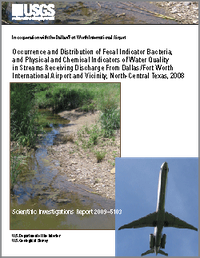Occurrence and distribution of fecal indicator bacteria, and physical and chemical indicators of water quality in streams receiving discharge from Dallas/Fort Worth International Airport and vicinity, North-Central Texas, 2008
Links
- More information: USGS Index Page (html)
- Download citation as: RIS | Dublin Core
Abstract
This report, done by the U.S. Geological Survey in cooperation with Dallas/Fort Worth International (DFW) Airport in 2008, describes the occurrence and distribution of fecal indicator bacteria (fecal coliform and Escherichia [E.] coli), and the physical and chemical indicators of water quality (relative to Texas Surface Water Quality Standards), in streams receiving discharge from DFW Airport and vicinity. At sampling sites in the lower West Fork Trinity River watershed during low-flow conditions, geometric mean E. coli counts for five of the eight West Fork Trinity River watershed sampling sites exceeded the Texas Commission on Environmental Quality E. coli criterion, thus not fully supporting contact recreation. Two of the five sites with geometric means that exceeded the contact recreation criterion are airport discharge sites, which here means that the major fraction of discharge at those sites is from DFW Airport. At sampling sites in the Elm Fork Trinity River watershed during low-flow conditions, geometric mean E. coli counts exceeded the geometric mean contact recreation criterion for seven (four airport, three non-airport) of 13 sampling sites. Under low-flow conditions in the lower West Fork Trinity River watershed, E. coli counts for airport discharge sites were significantly different from (lower than) E. coli counts for non-airport sites. Under low-flow conditions in the Elm Fork Trinity River watershed, there was no significant difference between E. coli counts for airport sites and non-airport sites. During stormflow conditions, fecal indicator bacteria counts at the most downstream (integrator) sites in each watershed were considerably higher than counts at those two sites during low-flow conditions. When stormflow sample counts are included with low-flow sample counts to compute a geometric mean for each site, classification changes from fully supporting to not fully supporting contact recreation on the basis of the geometric mean contact recreation criterion. All water temperature measurements at sampling sites in the lower West Fork Trinity River watershed were less than the maximum criterion for water temperature for the lower West Fork Trinity segment. Of the measurements at sampling sites in the Elm Fork Trinity River watershed, 95 percent were less than the maximum criterion for water temperature for the Elm Fork Trinity River segment. All dissolved oxygen concentrations were greater than the minimum criterion for stream segments classified as exceptional aquatic life use. Nearly all pH measurements were within the pH criterion range for the classified segments in both watersheds, except for those at one airport site. For sampling sites in the lower West Fork Trinity River watershed, all annual average dissolved solids concentrations were less than the maximum criterion for the lower West Fork Trinity segment. For sampling sites in the Elm Fork Trinity River, nine of the 13 sites (six airport, three non-airport) had annual averages that exceeded the maximum criterion for that segment. For ammonia, 23 samples from 12 different sites had concentrations that exceeded the screening level for ammonia. Of these 12 sites, only one non-airport site had more than the required number of exceedances to indicate a screening level concern. Stormflow total suspended solids concentrations were significantly higher than low-flow concentrations at the two integrator sites. For sampling sites in the lower West Fork Trinity River watershed, all annual average chloride concentrations were less than the maximum annual average chloride concentration criterion for that segment. For the 13 sampling sites in the Elm Fork Trinity River watershed, one non-airport site had an annual average concentration that exceeded the maximum annual average chloride concentration criterion for that segment.
Study Area
| Publication type | Report |
|---|---|
| Publication Subtype | USGS Numbered Series |
| Title | Occurrence and distribution of fecal indicator bacteria, and physical and chemical indicators of water quality in streams receiving discharge from Dallas/Fort Worth International Airport and vicinity, North-Central Texas, 2008 |
| Series title | Scientific Investigations Report |
| Series number | 2009-5103 |
| DOI | 10.3133/sir20095103 |
| Year Published | 2009 |
| Language | English |
| Publisher | U.S. Geological Survey |
| Publisher location | Reston, VA |
| Contributing office(s) | Texas Water Science Center |
| Description | vi, 45 p. |
| Time Range Start | 2008-01-01 |
| Time Range End | 2008-12-31 |
| Online Only (Y/N) | N |
| Additional Online Files (Y/N) | N |


